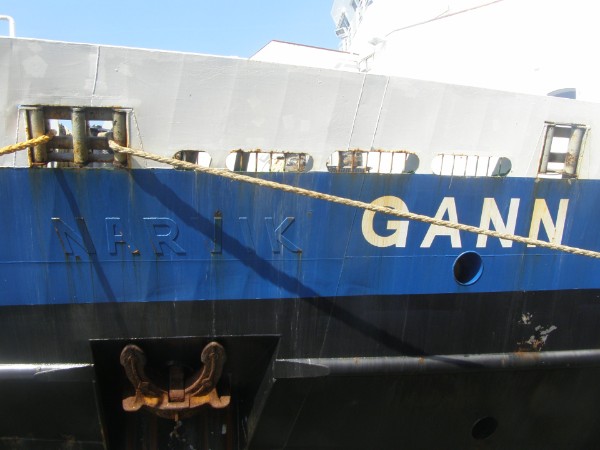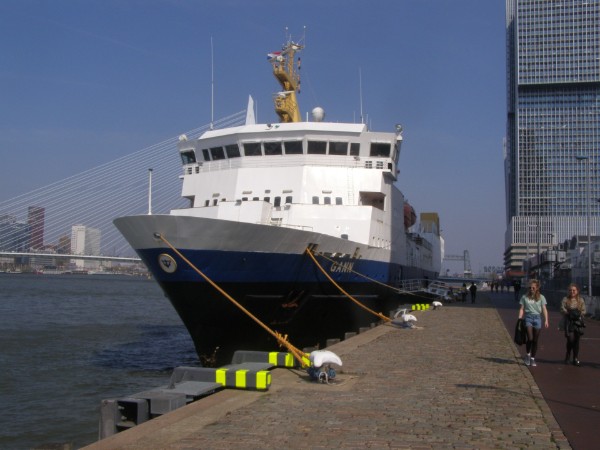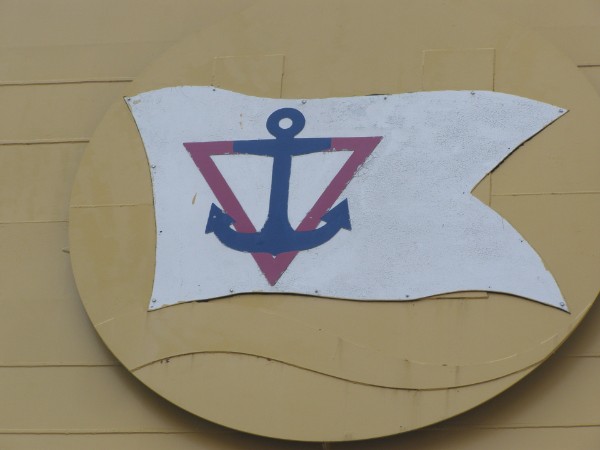Gann
Background
Below, Gann is shown docked at Rotterdam at the 7th of april in 2019.

The role of the Norwegian coastal service under the banner of Hurtig Ruten changed around 1980 when in the homecountry of Norway airtravel and better roads made the small communities at the coast reachable by other means then ships. The combine had been running the strategic coastal route from 1893 onwards and, although the changes were there, still was a very important part for the movement of goods, mail and people along the coast. So the combine acted in ordering a class of three larger and more modern ships for delivery in the early 1980's to strenghten the route. The ships became the Narvik, Mitnatsol and Vesteralen. Together, they replaced Mitnatsol from 1949, Vesteralen from 1950, Nordlys of 1950 and Hakon Jarl from 1952. The new class of ships was the largest ever ordered for the combine, easily twice the size of the 2000-tonners they replaced.
Construction and general statistics
The later Gann was originally built as the Narvik, one of only two Hurtig Ruten ships that have even been named after a town. She was built for the Det Ofotens Dampsskibsselskap (ODS) at the Trondhjems Mekaniske Verksted in Trondheim, Norway as yardnumber 827. Her lenght is 108,55 meters, she is 16,5 meters wide and her draft reaches 4,74 meters. Originally, she had a tonnage measurement of 4072 and space aboard for 166 passengers. The ship was driven by two 16-cylinder Bergen-design diesel engines that gave her a speed of around 17,5 knots. This said, within the fjords the speed is mostly considerably lower. She was launched at the 27th of april in 1982 and delivered to her company at the following 14th of december. Her homeport became Narvik, flying of course the Norwegian flag.
Easily to be spotted still is her former Hurtig Ruten name.

Design
There was a slight problem. The Norwegian State, which was a mayor on the construction costs and the route itself, had a total different idea about how these new mid-generation ships had te be designed then the operators within the Hurtig Ruten group. The operating companies liked to see higher capacity and ro-ro loading for cargo, but the State insisted in lower capacity and lifting arrangements for cargo. As they didn't really came together, the final design became a compromise. The passengercapacity became lower (even lower then the 1950's ships they replaced), but both loading types were installed. So the ships recieved two roro-decks and also the possibility for lifting aboard containers, for which they recieved a deck that was able to carry 22 of those. The first ship of the class, Mitnatsol, recieved an observation lounge on her top deck, but Narvik, the second ship, did not. So at the funnel of Narvik, the companies logo was painted, where by the Mitnatsol the funnel was blank and the logo was painted at the observation lounge. The lower passengercapacity proved to be a problem soon, as the ships were upgraded around 1989 when they had recieved a larger capacity then originally planned.
Carreer for Hurtig Ruten
Narvik sailed her first coastal service departing Bergen for Kirkenes at the 21st of december 1982 and she settled in along her older and newer sisters for the traditional voyages. In january of 1988, ODS merged with the Vesteraalens Dampsskibselskab (VDS) to form OVDS, continuing the Hurtig Ruten service with their partner Troms Fylkes Dampsskibselskab (TFDS). One year later, Narvik was send over to Bremerhaven for the rebuilding of her passengeraccomodations. At the Motorenwerke the capacity was increased from 166 to 380 for coastal services and 240 for cruises outside of the traditional route. The new cabins could be installed because the original containerdeck was going and the superstructure extended aft. So, finally, the original; plans from the operating companies came into being after all... Also, Narvik now recieved a large observationlounge at her top deck like her sisters and her tonnage measurement increased to 6257.
The face of Gann.

On the 16th of april in 1991, the ship grounded in a fierce storm near the town of Lysosund and her passengers and crew had to be evacuated by a local ferry, the Folla. She suffered considerable damage to her steering gears, rudder and propellers and she had a lot of waterdamage within the cabins, hallways and public spaces. But there had been no personal injuries and the ship was able to be repaired at the Viskerstrand Verft at Alesund, returning to service at the end of may 1991.
Like the trio of modern ships from the 1980's had replaced the older ships when they were introduced, the route kept changing drasticly when tourism came looking around the corner. While the 1980's had been a quite troublesome time economicly, the 1990's saw a huge boom in cruising in general and Hurtig Ruten became more and more a tourist destination next to a traditional ferry route. To cope with the increased demand, TFDS and OVDS ordered a series of new ships that were again far larger and that had more facilities for international cruise travellers. From the old postal route, the Hurtig Ruten now really became one of the best ways to see the fjords of Norway, still for a good price. The first of these new ships entered service in november 1993, named after the companies founder Richard With. As had happened before with their own introduction, several of the traditional postal ships were phased out as their purpose was now different. Firstly, several of the really older traditional ships went, but with even more new ships on the horizon also the trio of the 1980's came in sight. Mitnatsol was the first to leave in 2003, although she briefly returned in 2006 under the name of Lyngen, finally done away with in 2007 when she was sold to Lindblad Expeditions as the National Geographic Explorer. Narvik was eventually taken out of service in 2006 to become an housing vessel for Norsk Hydro. She was evenually sold to the Unge Sjomenns Kristne Forening (Young Seaman's Christian Association) in Stavanger, Norway to become a schooling vessel for students learning their nautical skills. She was finally delivered to her new owners in april of 2007 and recieved the name Gann. With this, she replaced another former Hurtig Ruten ship used under that same name. She in fact is the sixth ship under the name Gann, and the thirth former Hurtig Ruten ship in doing so.
The last of the three 1980's-built sisters, Vesteralen from 1983, still remains within the Hurtig Ruten fleet.
The Gann
Gann was of course rebuilt into a ship capable of educating students so they can be steamed up to work aboard Norwegian flagged ships within two or three years after they start their education. The former cardeck is rebuilt into a workshop and of course educational spaces are added. This said, the ship is still largely in her 'original' 1989 form and as the school is privately funded, the ship undertakes two cruises each year to gain more working capital. So she still has a lot of cruising-worthy capabilities on board, like comfortable lounges, a few bars and a restaurant, all done in stylish Norwegian quality with of course many nautical hints. The name Gann comes from the King of the mythological Fomorians, who are described as giants and seariders. Originally an Irish legend, but also largely linked to Norwegian folklore.

In april of 2007, Gann was one time chartered back to Hurtig Ruten for one voyage between Stavanger, her new hometown, and Geiranger, Hammerfest, Kirkenes and Bergen. After this, she started to fill in her new role.

